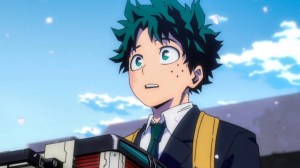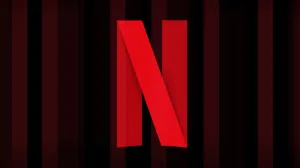Author R.L. Stine has been captivating audiences for decades with his tales of terror, with his work on the Goosebumps novels being particularly beloved among younger readers. Stine’s stories, along with cover art by Tim Jacobus, both intrigued and intimidated younger readers who were first getting a taste for spooky stories, igniting an interest not only in reading, but also in things that go bump in the night for young audiences. A new Goosebumps TV series is set to arrive on Disney+ that will appeal not only to the now-adult fans of the original novels, but also to entirely fresh fans, with Conor Welch and Pavun Shetty serving as producers on the new series. Goosebumps premieres on October 13th on Disney+ and Hulu.
Videos by ComicBook.com
Plunging viewers into a world of mystery and suspense, the new Goosebumps series follows a group of five high schoolers as they embark on a shadowy and twisted journey to investigate the tragic passing three decades earlier of a teen named Harold Biddle — while also unearthing dark secrets from their parents’ past.
Goosebumps stars Justin Long (Barbarian) and Rachael Harris (Lucifer), alongside newcomers Zack Morris (EastEnders), Isa Briones (Star Trek: Picard), Miles McKenna (Guilty Party), Ana Yi Puig (Gossip Girl), and Will Price (The Equalizer).
ComicBook.com caught up with the producers to talk the new series, honoring the source material, and what the future could hold.

ComicBook.com: This has such an interesting approach in the way it delivers its own standalone, wraparound storyline featuring these kids while also integrating the original stories in organic ways. So from the beginning, was this always the approach to developing that or did it evolve and shift back and forth between being its own thing and being more authentic adaptations?
Pavun Shetty: I mean, it definitely evolved and it’s a great point because the books, which we grew up on, were very anthological. The original ’90s series was very anthological, and we were lucky to have access to all of the books. So we needed to decide, are we doing a show where every episode is purely self-contained with a new cast and new issue, or are we going to do something more serialized?
I think we did a little bit of a hybrid that leans more towards the serialized nature. We decided to take five of the most popular books and incorporate them for the first five episodes, where you’re following a different character, going through different hauntings from one of these books. So there is a standalone nature to what they’re doing, but then in the middle of the season they realize that they’re all going through this individually, and they come together, and from that point on they team up to survive and save the town. And then, we pulled Easter eggs from various books and threw them in for the rest of the season.
Was it very clear from the get-go, “These are the five we need to go with,” or was it, “Well, we want to do this one, but it doesn’t weave its way into the story as organically,”?
Conor Welch: We wanted, certainly, to incorporate five of the more popular books early on, but really the reason that we chose the five that we did were because they had very, very relatable, adolescent, evergreen issues at the core of them. The mask that haunts the girl who feels like she doesn’t have an identity, but becomes an internet troll and then that turns into becoming a real troll. So it’s little nuggets of actual, tangible, relatable issues. Those are the most important things for us. And then when you add on to that the haunting and elevate it with the genre, it just becomes more cinematic and exciting. But always, always for us, the most important thing was for it to be grounded in relatable emotional things.
R.L. Stine is such a prolific creative. What were the conversations like with him? Did he offer any impact or any feedback whatsoever or did he let the series just do its own thing?
Welch: A little bit of both. Basically, we had a meeting with him early on, which was a true career highlight considering how seminal he was to my wanting to be a storyteller myself. But really he just talked about where the series came from and it was similarly relatable, everyday issues exploded to this genre place, but always cut with levity and humor.
We wanted to use that as our North Star, and then thereafter, he would read scripts and watch cuts and stuff, but always was very, very positive. When he sent an email after watching the pilot for the first time, saying how much he liked it and how happy he was with the direction that we ended up going, it was just a really, really thrilling thing.
Not only are the books so important to so many young readers, but then there’s the TV show and then there’s the two movies. Did you explicitly approach this as, “Here’s how we’re going to set ourselves apart, and here’s how we’re going to honor those previous adaptations,” or did you not even want to consider other adaptations when developing this show?
Shetty: Well, I think, for me, I had a personal connection because I read the books growing up, but then there’s also a more practical one, which is the company I worked for the original film, actually produced the movies. The director of the first movie, Rob Letterman, also created this version of the Goosebumps show and directed the first episode. He came up with the idea for the TV show, and when we talked about what it could be, it was really important to us that we honor what people loved about the original because we don’t underestimate how important these books are in people’s lives. But we also wanted to update them and subvert expectations on people to be surprised when we did them. We wouldn’t have done it unless it had a reason for existing on its own, so we wanted to make the humor be a little bit more sophisticated. We wanted the scares to be a little bit more intense, and we really wanted the issues that everyone was facing to feel authentic.
The last thing I’ll say with that is that we wanted parents to be able to watch the show on their own, and we wanted the issues that the adults were grappling with to be really identifiable. We had the core stories, and we had the humor and horror that was embedded in the original stories that R.L. Stine created, and we wanted to develop a full, serialized show around that. Those books were always on our mind when we developed this.
Going along with that, I especially appreciated, being an adult, the show is a little bit more PG-13 in tone than when I revisit the ’90s series. I’m like, “This doesn’t entirely hold up,” even if the core nuggets are still entertaining. What was that process like of finding the right tone, because it’s almost even PG-15. There’s definitely some very intense stuff in there. Was that ever a conversation of, “This is Disney+, let’s make it a little bit more accessible” versus setting itself apart from the ’90s series?”
Welch: Totally. It was always a conversation, and it was always wanting to toe that line as best we could, right? Because the books always felt like they were a little scarier, a little more elevated than maybe I should be reading at the time. We wanted the television show to feel the same way, that the jokes were a little edgier, but not inappropriate. That the scares were a little more intense, but never gory. We always had that line, that North Star in mind, but wanted to get up right at the edge of it. Because we’d never wanted to, as the books don’t, ever wanted to pander to kids. We never wanted to talk down to kids, and we never wanted the adult audience to be bored with something that felt juvenile. All of those things were kept in mind. And I think Rob Letterman, Nick Stoller, and Hilary Winston, our showrunner, really did an excellent job of toeing that tightrope the whole way through.
Shetty: And being that high school kid is awkward, which is super funny, and it’s also really scary. And so those things are inherent to the age, to our characters in the show, and so it was easy to pull from those real experiences that high school kids have and embed them in a show with actual scares.
R.L. Stine not only had Goosebumps, he had Fear Street, he’s still publishing stuff, shockingly. He’s still this creative force. What do you feel it is about R.L. Stine that sets him apart from other storytellers in the genre, either just horror storytellers in general or more in terms of younger readers who are just getting interested in the genre?
Shetty: I think there’s two things, and they’re particular to the Goosebumps books, are that he never pandered to kids. He always treated kids like they were adults, which is why people of all ages could read the books. I think the second thing is that the books were always scary, but also funny. He ended every chapter with a punchline. I think that was really important to the DNA of the books, and that’s what sets them apart, and it’s why they’re so relatable and popular and timeless. When we created the show, that was extremely important to us, that we embraced that when we developed this.
What I liked is the way that it’s balanced to bring original material and then honor the source material, and I noticed there’s definitely some direct changes from the source material to how it’s brought to life in the show. Was there any apprehension around that, of, “We might upset some devout fans the way we tweaked the storyline,” or did it feel totally organic?
Welch: It felt very organic. As fans ourselves, we felt like we could see it through that prism. It was always intentional to have the DNA of the series, but never to feel like we had to be faithful to the storytelling. R.L. Stine and Scholastic were very generous with us to let us run with it in the way that we did. I think as huge fans ourselves, we always kept that in mind, like, “Will fellow fans like this?” And if the answer was, “Yes,” we felt confident running with it.
Looking to the future, I know we have to wait and see how fans really connect with the series, but have there been any even just initial talks of, if there’s a Season 2, Season 3, or whatever, do you think we can expect to see these characters on future journeys or would it be another new set of characters, another way to weave an entirely original story together?
Welch: We lucked out so significantly with the cast that we were able to assemble for this show. These five relatively unknown young adult actors just immediately found a chemistry and were able to play into their very natural and organic dynamics they had within the group. So yeah, our hope is to follow this group of kids and adults for many, many more seasons and many, many more episodes to come. Because we do have every one of the books of the canon at our disposal, and there’s just a lot more to dig into.
Goosebumps premieres on October 13th on Disney+ and Hulu.
This interview has been edited for length and clarity. You can contact Patrick Cavanaugh directly on Twitter.








